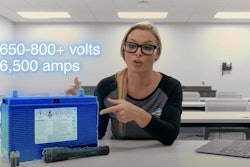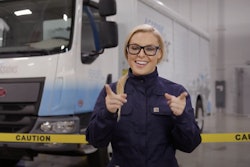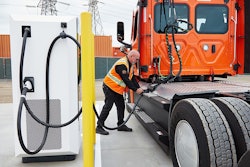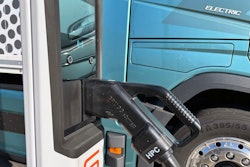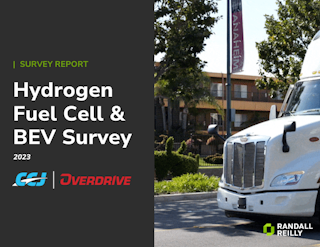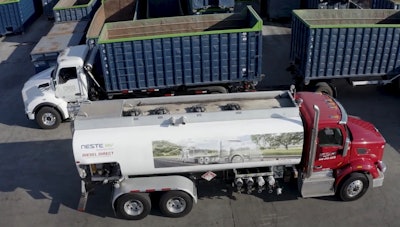
By switching to renewable diesel in California, a fleet can save roughly 40 cents per gallon while lowering their emissions and enjoying other benefits like improved fuel economy and a reduction in regen cycles.
But that’s California, where renewable diesel is subsidized by the state’s Low Carbon Fuel Standard. The odds of finding the fuel outside of the Golden State are slim and may get even slimmer if the state’s troubling LCFS credit performance is repeated in other states and countries that are following in California’s footsteps with their own low carbon fuel programs.
Under California’s LCFS program, low carbon fuel producers earn credits funded by other fuel companies that produce fuels with higher carbon content like conventional diesel and gasoline. These credits help lower the cost of low carbon fuels like renewable diesel.
On Thursday, according to AAA, the average price of conventional diesel in California was $4.88. Propel Fuels, which operates at least 30 retail stations statewide, was selling its Diesel HPR (high-performance renewable) at $4.49 in Wilmington near Long Beach, a 39-cent savings over the state average.
[Related: Penske is 'huge proponent of renewable diesel']
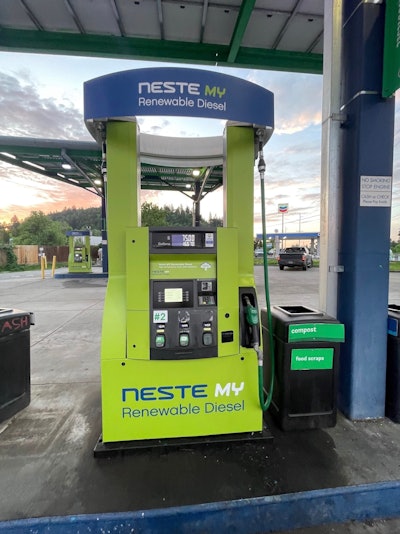 Renewable diesel is mostly available in California though expansion efforts are underway in Oregon and Washington State which have adopted Low Carbon Fuel Standard programs similar to the one used in California.Neste
Renewable diesel is mostly available in California though expansion efforts are underway in Oregon and Washington State which have adopted Low Carbon Fuel Standard programs similar to the one used in California.Neste
In its 2023 State of Sustainable Fleets report, Gladstein Neandross & Associates state that renewable diesel (RD) enjoyed stellar year-over-year growth. Domestic production swelled from 800 million gallons in 2021 to over 1.7 billion gallons in 2022.
“On the demand side, national RD consumption increased by more than 45% for the second year in a row, and it represented 83% of all bio-based diesel (BD) consumed in transportation in California for the first three quarters of 2023,” the May report states. “For the first time since the inception of the annual State of Sustainable Fleets survey of fleets, more fleets report using RD than BD.”
However, the outlook for renewable diesel production, GNA cautions, could be hampered by a big drop in LCFS credit values.
“During the last 18 months, California’s LCFS credit bank has ballooned as the supply of credit-earning fuels, including RD, has increased, driving credit prices as low as $56/MT (per metric ton) — about one-fourth of the market high of $219/MT in 2020," GNA's Sustainable Fleets report states. "Several renewable fuel industries are facing higher operating costs, and without the support of strong LCFS revenues, stakeholders observe that the growth trajectory for RD may slow down until prices recover to at least $125 per credit.”
The LCFS is being amended to help address credit value concerns, but “program officials have indicated that the rulemaking process could extend into mid-2024.”
Other solutions beyond slow LCFS approach?
After California introduced its LCFS program in 2009, only two other states have followed suit with similar programs: Oregon and Washington. According to GNA, California has also been assisting British Columbia and Brazil with LCFS adoption.In the U.S., the outlook for additional LCFS program rollouts isn’t exactly rosy.
“At the beginning of 2023, Washington joined Oregon as the only other state besides California with a market akin to the LCFS,” GNA states in its Sustainable Fleets report. “Beyond the West Coast, other states have been looking at adopting similar programs, including Minnesota, New Mexico and New York. While these states have all introduced state bills to create their own programs for several years, they remain stalled.”
Even with Washington and Oregon on board with LCFS programs, renewable diesel availability is nothing like it is in California. For instance, fuel retail giant 76 has 200 stations within a 100-mile radius of San Diego that offer renewable diesel. Oregon and Washington are currently showing only one 76 station in each state.
Neste, the world’s largest producer of renewable diesel and Propel’s supplier, doesn’t envision much renewable diesel expansion without government help.
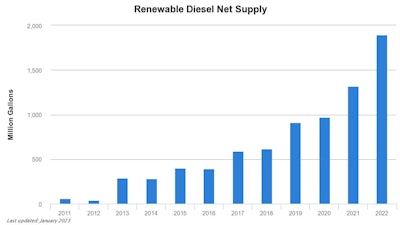 Renewable diesel supply levels have steadily increased in the U.S.EPA
Renewable diesel supply levels have steadily increased in the U.S.EPA
Rick Mihelic, director of emerging technologies at the North American Council for Freight Efficiency (NACFE), pointed to other possible paths to incentivizing renewable diesel outside of an LCFS program.
“How the reduction in emissions is monetized matters in making RD economically viable. For example, if there are no credits like LCFS, are there grants or tax incentives for running at a lower emission level? Are there customers willing to pay more for deliveries with RD-fueled vehicles? Can fossil diesel or the vehicles they run in be made more expensive through registration fees, fuel tax surcharges, etc., or conversely can RD trucks be made cheaper through reduced registration, reduced excise tax or lower fuel taxes?” Mihelic said.
Fuel stations and other supply chain players could also be subsidized to help defray costs.
“Can the fuel station pumping RD be subsidized/credited for providing the fuel, reducing the overhead for the facility, which could reduce the fuel price?” Mihelic continued. “The supply chain that creates the RD likely has ways to be influenced to reduce the cost. For example, how much of the supply chain is zero emission power, hydrogen production, etc. There are probably many new ways to look at cost justifying RD using both stick and carrot approaches beyond LCFS.”
Allen Schaeffer, executive director of the Diesel Technology Forum, pointed out that states have largely been following the federal government’s lead when employing low carbon fuel programs of their own. In other words, if federal funding favors certain paths to emissions reduction, states that don’t have sizable revenue streams like California are less likely to support a wider selection of alt fuels. The Biden administration's Inflation Reduction Act is an example.
“The Inflation Reduction Act tipped the dollars and scales largely toward electrification – and we know that the dollars and opportunities that are available there are driving a lot of the thinking at the state level,” Schaeffer said.


